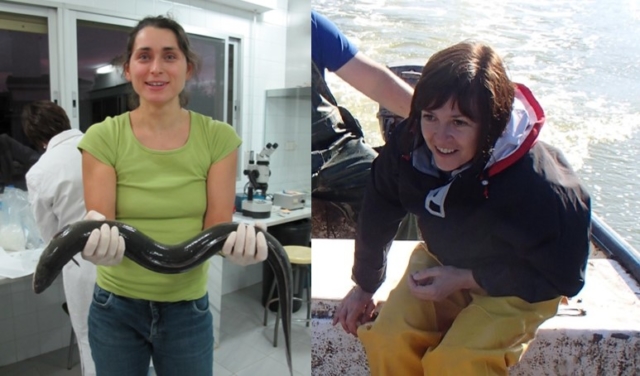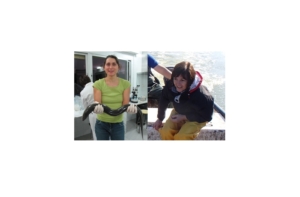 Elsa Amilhat, a research engineer, and Elisabeth Faliex, a university professor, work on research projects in the Centre de Formation et de Recherche sur les Environnements Méditerranéens (Mediterranean habitat training and research center (CEFREM)) at the University of Perpignan. Both scientists have been engaged in research on eel for more than 10 years, and are advancing knowledge in fields as far ranging as eel health, migratory behaviour, and population trends. They participate in the Management Committee of the Mediterranean Rhone basin’s Migratory Fish Management (PLAGEPOMI), and Elsa has been in the international working group on eels (WGEEL) since 2015. Below they respond to questions from the Tour du Valat concerning the European Eel.
Elsa Amilhat, a research engineer, and Elisabeth Faliex, a university professor, work on research projects in the Centre de Formation et de Recherche sur les Environnements Méditerranéens (Mediterranean habitat training and research center (CEFREM)) at the University of Perpignan. Both scientists have been engaged in research on eel for more than 10 years, and are advancing knowledge in fields as far ranging as eel health, migratory behaviour, and population trends. They participate in the Management Committee of the Mediterranean Rhone basin’s Migratory Fish Management (PLAGEPOMI), and Elsa has been in the international working group on eels (WGEEL) since 2015. Below they respond to questions from the Tour du Valat concerning the European Eel.
- Since its creation, the WGEEL Working Group on Eels has been meeting regularly to exchange information on the European eel. What is this group? What are its role and objectives?
The Working Group on Eels (WGEEL) is a group of eel scientists first brought together in 1968 by EIFAC (European Inland Fisheries and Aquaculture Commission, itself an offshoot of the FAO). This group has made a major contribution to and advanced knowledge on the European eel. Alerted by the collapse of the eel stock, it has played a major role internationally in raising the awareness and consciousness of the various stakeholders involved in eel management, in supporting and developing monitoring and assessment of the eel stock, and also in building the framework in which European Eel Regulations have been established.
The group has been meeting annually since 2001 (under the aegis of EIFAC and the International Council for the Exploration of the Sea ICES) to analyse the most recent data on the European Eel population and assess trends in recruitment, professional and recreational fisheries, illegal fishing, and restocking. On the basis of these results, the ICES gives its opinion to the European Commission through its Advisory Committee (ACOM). It is a somewhat complex process, but it allows for several reviews and checks.
In 2014, seeing the need to fill the data gap in the non-European part of its distribution area, the General Fisheries Commission for the Mediterranean (GFCM) joined the working group along with ICES/EFIAC for the international assessment of the current eel stock.
The WGEEL has a new annual activity since 2019, which consists in examining and quantifying the impacts of factors not linked to fishing. In 2019, it made a review of the impacts of hydropower and pumping stations, and in 2020, the impacts related to habitat loss. In 2021, the group should study the effects of contaminants on the eel’s reproductive potential. It is interesting to note that in addition to its annual meetings, the WGEEL has initiated the establishment of other international working groups, such as a group on the age of European and American Eels (2009, 2011, and 2019), another on the development of a call for data (2017 and 2019), and one on the biological effects of contaminants (2016). The working group reports are available online on the ICES website; unfortunately, [1]they are all in English and therefore not always easily accessible to some stakeholders.
- What is the current state of knowledge on the eel stock in the Mediterranean Basin compared to that of the Atlantic?
Although our knowledge about the Mediterranean is gradually improving, less monitoring and study activities take place there than on the Atlantic coast. However, it is in the Mediterranean that we find one of the eel’s flagship habitats: lagoons, which are numerous and represent a total surface area of more than 575 km². Being very productive, they produce a large number of silver eels in record time and could, according to estimates, produce annually more than half of the silver eels that leave France to reproduce. In the Mediterranean, there is a lack of long-term elver recruitment monitoring stations for juvenile stages of eels colonising continental and transitional waters, and for the downstream migration of silver eels (future spawners that go out to sea to reproduce). However, such monitoring is essential to assess the population’s recovery! There are currently only three long-term recruitment monitoring stations in the Mediterranean zone: two in Spain (Albufera Lagoon and Ebro Delta), which are based on commercial fishing, and one in France at Fourcade inlet in the Vaccarès Lagoon, based on a scientific protocol. As far as long-term silver eel monitoring stations are concerned, there is only one in the Mediterranean, which monitors silver eel catches in the Albufera Lagoon in Spain (compared to more than twenty on the Atlantic and North Sea).
In 2018, we started a project to monitor the recruitment and downstream migration in the channel of the Bages-Sigean Lagoon, but for the moment we only have funding for 3 years. It is therefore not certain that our data can ever be used in the WGEEL’s international stock assessment, as this assessment requires series of at least 10 years. The idea would therefore be to continue these two stations in order to have more data concerning the Mediterranean.
The needs in the Rhone-Mediterranean Basin are now fairly well identified and reported in the PLAGEPOMI (Management Committee of the Mediterranean Rhone basin’s Migratory Fish Management) document, designed during meetings and discussions between the various stakeholders involved in eel management in the Basin. However, it is still difficult to deploy the necessary financial resources.
- Concerning Mediterranean lagoons, what are your projects to improve this knowledge on eels?
We have undertaken several projects in the aim of filling the gaps we have in the Mediterranean. Our main project, FLUX, consists in evaluating and understanding eel recruitment dynamics and eel migration in the Bages-Sigean pilot lagoon. We chose this lagoon because it has only one opening to the sea and its harbour channel provides the necessary facilities for our monitoring systems. This 3-year project, financed by the Water Agency, the Occitania Region and the Ministry of Agriculture and Food, is coming to an end in 2021, and will provide new information, not only in terms of understanding eel migration, but also in terms of the methods used. We are also involved in an ambitious international project, led by the General Fisheries Commission for the Mediterranean, whose final objective is to set up a common framework for the coordinated management of eels in the Mediterranean with a view to the recovery of the population. 9 countries are involved: Algeria, Tunisia, Egypt, Albania, Turkey, Greece, Italy, France, and Spain. The idea is first to take stock of the eel’s habitats, numbers, and the anthropogenic pressures it is facing in the Mediterranean. Together we will identify and evaluate management and protection measures, and try to establish a common framework for long-term eel monitoring and stock assessment. We are also in the process of completing a European INTEREG project: SUDOANG, which aims to harmonise methods for studying eels in the SUDOE zone (Spain, France, and Portugal).
We have also participated in the scientific monitoring of silver eel releases carried out since 2011 in the Occitania Region, a project completed by professional fishermen and financed by the Ministry of Agriculture and Food. This monitoring enables us to have a unique database on the biological characteristics of the future spawners coming out of some ten lagoons in the region. Thanks to this programme and the help of professional fishers, we have been able to mark large females with satellite tags in order to know the migration routes at sea and to show that they do indeed swim out at Gibraltar, and can therefore contribute to the breeding stock.
- What is the relevance of the long-term monitoring carried out in the Camargue?
The Camargue was a forerunner in setting up long-term monitoring. We can cite in particular two elver recruitment monitoring operations: one carried out since 1993 in the Vaccarès Lagoon, and another since 2004 in the fishway trap at the Fourcade inlet, which is ongoing today. Let’s hope it continues! This long-term monitoring is of great importance because it allows us to reduce inter-annual variations and to observe and understand eel stock trends.
It should be noted that the monitoring at the Fourcade inlet is the only time series of data used in France by the WGEEL to assess the status of European Eel stock.
